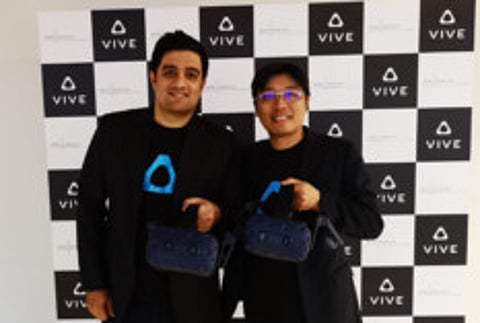HTC expects VR and AR to take off with 5G protocol
Aims to bring the VR technology to normal eyewear but may take around five years

Dubai: HTC expects the demand for virtual reality (VR) and augmented reality (AR) headsets to increase when the fifth generation wireless mobile network launches in 2020.
Raymond Pao, vice-president of product and strategy and general manager of Asia at HTC Vive, told Gulf News that the intake of VR sets in 2016 was by consumers but from last year more verticals such as education, real estate, health care are using VR.
“VR and AR could be the perfect fit for 5G. There are limitations for current devices but with a better communication protocol, we can move more computing power to the cloud. By that way, we can make the device lighter. We can avoid the cable and cloud connection,” he said.
The Taiwanese company launched its new VR headset — Vive Pro — in Dubai on Wednesday.
The Pro will be available for Dh3,299 without controllers from middle of June at retail outlets but it is available at Burj Khalifa store and e-commerce portal.
While it has the same 3.5 inches as the older Vive, the Dual AMOLED screens Vive Pro has a resolution of 1440 x 1600 at 615 pixels per inch per eye compared to the 1080 x 1200 resolution at 448 pixels per inch of the original Vive.
From the technology perspective, Pao said that VR, AR and MR (mixed reality, a combination of VR and AR) share the same technology but the use case and the display technology is different.
“AR is more complicated but we are seeing more enterprise usage for VR and AR and, at the same time, mobile phone vendors are also adopting AR into their devices. From the performance perspective, we are seeing the VR headsets improving. Sony VR is the fastest selling as they have a loyal gaming consumer base but HTC Vive is still the best in terms of performance,” he said.
According to research firm International Data Corporation (IDC), the global spending on AR/VR is forecast to reach $17.8 billion (Dh65.3 billion) in 2018, an increase of nearly 95 per cent over the $9.1 billion expected in 2017.
Annual growth rate
IDC said that the consumer sector will remain the single largest source of spending for AR/VR products and services with worldwide spending in 2018 expected to reach $6.8 billion. Gaming will be the dominant AR/VR use case for consumers throughout the forecast 2016-2021. The five-year annual growth rate for consumer AR/VR spending will be 45.2 per cent of total spending exceeding $20 billion in 2021.
On a geographic basis, the US will be the region with the largest AR/VR spending total in 2018 ($6.4 billion), followed by Asia/Pacific (excluding Japan) ($5.1 billion) and Europe, the Middle East and Africa (EMEA) ($3 billion).
Pao said that the vision for HTC is to bring the VR technology to the normal eyewear.
“We need to overcome so many barriers and it may take between three to five years. What we are now planning is how to make the headset lighter and improve the resolution,” he said.
With the existing communication protocol, he said that it is difficult to make it work on Wi-Fi and Bluetooth due to the latency and bandwidth.
“We will be launching an additional dongle for Vive Pro in summer and with that you can use it as a wireless device,” he said.
Partnership with retailers
The company has three devices — HTC Vive for consumers, HTC Vive Pro for prosumers and enterprises and HTC Vive Business Edition.
“HTC Vive Business Edition, which was launched earlier, will be discontinued soon as it is causing confusion in the market,” he said.
Ramit Harisinghani, vice-president and head of Middle East & Africa at HTC Vive, said the take-off in the region has been good as “we have built partnerships with retailers and recently we launched e-commerce portal as well. It has grown multi-fold in the last three years.
“Our first priority was people to understand was VR is and then what Vive is. We achieved it with a lot of demos and partnerships came into play,” he said.
It has more than 3,000 VR apps on the HTC Vive Port App Store and Vive X, a global accelerator fund specialises in the virtual reality sector.
“There is no Arabic content on the apps store right now but I do see developers coming in to build local content,” he said.
Sign up for the Daily Briefing
Get the latest news and updates straight to your inbox



